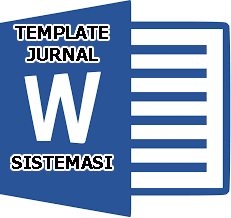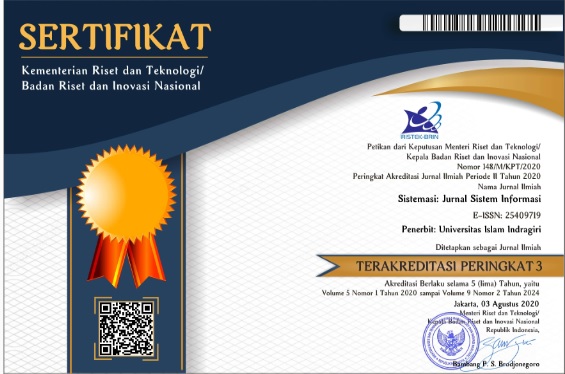Usability Evaluation of Azkiya Creative Application at Pondok Pesantren Modern Al-Azkiya' Pengalihan Keritang Village Using the System Usability Scale (SUS) Method Al-Azkiya’ Desa Pengalihan Keritang Menggunakan Metode System Usability Scale (Sus)
Abstract
Full Text:
PDFReferences
H. Susanto, J. Jamaludin, and M. Prawitasari, “Evaluasi Rancang Bangun Aplikasi Pembelajaran Sejarah Proklamasi Berbasis Android,” ANDHARUPA J. Desain Komun. Vis. Multimed., vol. 9, no. 01, pp. 130–143, 2023, doi: 10.33633/andharupa.v9i01.7054.
V. Y. P. Ardhana, “Evaluasi Usability E-Learning Universitas Qamarul Huda Menggunakan System Usability Scale (SUS),” J. Informatics, Electr. Electron. Eng., vol. 2, no. 1, pp. 5–11, 2022, doi: 10.47065/jieee.v2i1.430.
V. P. Sabandar and H. B. Santoso, “Evaluasi Aplikasi Media Pembelajaran Statistika Dasar Menggunakan Metode Usability Testing,” Teknika, vol. 7, no. 1, pp. 50–59, 2018, doi: 10.34148/teknika.v7i1.81.
L. P. Penelitian and R. Riyandi, “Menggunakan Metode System Usability Scale,” vol. 12, no. 2, 2021.
A. D. Hidayat, R. F. Nurkhalim, and N. Nurhadi, “Evaluasi Kebermanfaatan Aplikasi Salve Menggunakan Metode System Usability Scale (Sus),” J. Wiyata Penelit. Sains dan Kesehat., vol. 9, no. 2, p. 162, 2022, doi: 10.56710/wiyata.v9i2.599.
M. Syariat and Samsudin, “Sistem Informasi Penjualan Pada Toko Faisal Elektronik 2 Indragiri Hilir Berbasis Web,” J. Perangkat Lunak, vol. 2, no. 1, pp. 51–62, 2020, doi: 10.32520/jupel.v2i1.1084.
H. Al Rosyid, D. P. Rakhmadani, and S. D. Alika, “Evaluasi Usability pada Aplikasi OVO Menggunakan Metode System Usability Scale ( SUS ),” vol. 9, no. 6, pp. 1808–1815, 2022, doi: 10.30865/jurikom.v9i6.5073.
M. M. Muhtarom, A. Suyatno, and T. D. S, “Evaluasi Sistem Informasi Pembayaran Siswa SMK Mandala Bhakti Surakarta,” Device, vol. 12, no. 2, pp. 119–125, 2022, doi: 10.32699/device.v12i2.3493.
F. G. Sembodo, G. F. Fitriana, and N. A. Prasetyo, “Evaluasi Usability Website Shopee Menggunakan System Usability Scale (SUS),” J. Appl. Informatics Comput., vol. 5, no. 2, pp. 146–150, 2021, doi: 10.30871/jaic.v5i2.3293.
E. Kaban, K. Candra Brata, and A. Hendra Brata, “Evaluasi Usability Menggunakan Metode System Usability Scale (SUS) Dan Discovery Prototyping Pada Aplikasi PLN Mobile (Studi Kasus PT. PLN),” J. Pengemb. Teknol. Inf. dan Ilmu Komput., vol. 4, no. 10, pp. 3281–3290, 2020.
U. Ependi, A. Putra, and F. Panjaitan, “Evaluasi tingkat kebergunaan aplikasi administrasi penduduk menggunakan teknik system usability scale,” Regist. J. Ilm. Teknol. Sist. Inf., vol. 5, no. 1, pp. 63–76, 2019, doi: 10.26594/register.v5i1.1412.
D. Made, D. Utami, and A. M. Dirgayusari, “Usability Testing Website Dengan Menggunakan Metode System Usability Scale ( Sus ) s,” vol. 4, no. October, pp. 152–161, 2020.
G. Indrawan et al., “Evaluasi Sistem Informasi SIAkad UPMI Mengunakan Metode System Usability Scale,” pp. 61–70.
Sabrina Aisyah, Eki Saputra, Nesdi Evrilyan Rozanda, and Tengku Khairil Ahsyar, “Evaluasi Usability Website Dinas Pendidikan Provinsi Riau Menggunakan Metode System Usability Scale,” Jurnal Ilmiah Rekayasa dan Manajemen Sistem Informasi, vol. 7, no. 2. pp. 125–132, 2021. [Online]. Available: https://disdik.riau.go.id.
H. Annaasthasya Suryanto and R. Setyadi, “Evaluasi Web Sistem Informasi Pemerintahan Daerah (SIPD) Bappelitbangda Mempergunakan Metode System Usability Scale,” RESOLUSI Rekayasa Tek. Inform. dan Inf., vol. 3, no. 2, pp. 156–161, 2022, [Online]. Available: https://djournals.com/resolusi
DOI: https://doi.org/10.32520/stmsi.v13i4.4261
Article Metrics
Abstract view : 453 timesPDF - 121 times
Refbacks
- There are currently no refbacks.

This work is licensed under a Creative Commons Attribution-ShareAlike 4.0 International License.









